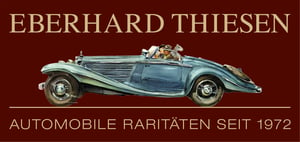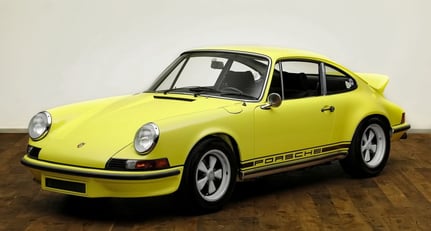1972 Porsche 911
Carrera RS 2.7 Touring-
Year of manufacture1972
-
Mileage89 005 km / 55 306 mi
-
Car typeCoupé
-
DriveLHD
-
ConditionRestored
-
Exterior brand colourCode 117-8-1
-
Interior colourBlack
-
Number of doors2
-
Number of seats2
-
Location

-
Exterior colourYellow
-
GearboxManual
-
Performance210 PS / 155 kW / 208 BHP
-
Drivetrain2wd
-
Fuel typePetrol
Description
• Originales Farbschema in hellgelb vor ca. 20 Jahren neu lackiert und Interieur in schwarzer Kunstleder/Stoff-Kombination
• Besitzhistorie vollständig bekannt mit nur vier Eigentümern in Norddeutschland, davon über 30 Jahre beim vorletzten Besitzer
• Originaler Pflegepass und Bordliteratur sowie umfangreiche Rechnungsdokumentation vorhanden
• Der Motor wurde nach RS-Spezifikationen von einem anerkannten Motorenspezialisten neu aufgebaut; Technik teilrevidiert
• Karosserie und Technik bei bekanntem Spezialisten überarbeitet
Der Porsche 911 2.7 Carrera RS wurde 1972 zur Homologation für den Rallye- und Rennsport aufgelegt und entwickelte sich zum Verkaufsaschlager. Statt der erforderlichen 500 Exemplare letztlich 1.580 Fahrzeuge hergestellt, davon 1.308 als komfortoptimierte „Touring“-Version. Heute gehört diese 911-Version zu den legendären und raren Klassiker-Modellen von Porsche. Dieser 911 Carrera RS Touring (Code M472) wurde über das Autohaus Schmidt-Koch in Bremen ausgeliefert und am 11.12.1972 auf ein Unternehmen in Bremen erstzugelassen (Name bekannt). Anhand der Fahrgestellnummer ist es das 104. gebaute Fahrzeug und gehört somit zu den ersten 500 Exemplaren, die für die Homologation gefertigt wurden. Das originale Farbschema war und ist „hellgelb“ (Farbcode 117-8-1) mit Interieur in schwarz, wobei die Recaro Sportsitze in einer Stoff/Kunstleder-Kombination ausgeführt sind. Die Lackierung wurde im Zuge der partiellen Überarbeitung der Karosserie (u.a. Türschweller) Mitte der 1990er Jahre erneuert. Im April 1980 erfolgte der Verkauf an den zweiten Besitzer in Hamburg. Bereits im Mai 1981 wurde der Wagen an die dritten Besitzer, ein Ehepaar im Norden Hamburgs, weitergab. Der alte originale Fahrzeugbrief über diese Eigentümer ist vorhanden. Das Ehepaar behielt den Carrera RS ganze 33 Jahre lang und nutzte den Wagen regelmäßig. Aus dieser Zeit sind zahlreiche Rechnungen zu Service-, Reparatur und Überholungsarbeiten vorhanden. Einige dieser zum Teil umfangreicheren Arbeiten wurden beim bekannten Porsche 911 Spezialisten Ingo Stimming in Schleswig-Holstein ausgeführt. Seit 2014 ist der Carrera RS bei seinem vierten und aktuellen Besitzer in Hamburg. Der Motor wurde im Jahr 2015 beim einem bekannten Motorenspezialisten nach Carrera RS-Spezifikationen mit entsprechender Leistung neu aufgebaut bzw. revidiert. Eine entsprechende Rechnung und Leistungsmessung liegen vor. Im Zuge dessen wurden eine neue Kupplung verbaut und das vorhandene 915-Getriebe überarbeitet. Die Lagerungen, Ölpumpe und die Hauptlager der Kurbelwelle wurden ebenfalls erneuert und die Drosselklappen des Einspritzsystems ersetzt.
Der Porsche 911 wurde 1964 als Nachfolger des 356 vorgestellt. Er wurde dann knapp 10 Jahre als erste Generation – sog. „F-Modell“ oder auch „Urmodell“ – mit zahlreichen Modifikationen in diversen Varianten gebaut bis es 1973 vom gründlich überarbeiteten „G-Modell“ abgelöst wurde. Im Oktober 1972 wurde auf dem Automobilsalon in Paris der heute legendäre Carrera RS 2.7 vorgestellt. RS steht für Rennsport und dieses Modell war eigentlich nur zur Homologation im Rallye- und Motorsport mit einer erforderlichen Stückzahl von 500 gedacht. Gewicht, Motor, Fahrwerk und Aerodynamik werden intensiv für den Motorsporteinsatz optimiert. Ende November sind bereits alle 500 Fahrzeuge verkauft und Porsche beschließt, die Fertigung fortzusetzen. Der luftgekühlte Sechszylinder-Boxermotor mit 2,7 Liter Hubraum (Baumuster 911/83) verfügte über eine mechanische Doppelreihen-Einspritzpumpe und leistet 210 PS. Als erster 911 erhält er wieder die Bezeichnung „Carrera“, die schon zuvor die leistungsstärksten 356-Modelle kennzeichneten. Mit einer Höchstgeschwindigkeit von 245 km/h war der Carrera RS seiner Zeit das schnellste deutsche Serienfahrzeug und zudem auch der erste Straßensportwagen der Welt mit Bug- und Heckspoiler. Der markante Heckspoiler mit dem Beinamen „Entenbürzel“ verbesserte die Fahrstabilität erheblich. Der spezielle Frontspoiler hatte für den Ölkühler in der Mitte eine Öffnung. Unterschiedlich breite Räder an der Vorder- und Hinterachse sorgten für höhere Kurvengeschwindigkeiten und eine stärkere Bremsleistung. Im Bereich der Hinterachse ist die Karosserie 42 Millimeter breiter. Um das Gewicht für die Homologation zu reduzieren wurden u.a. Dünnbleche, Kunststoffteile und Dünnglasfenster verbaut und auf Dämmung verzichtet. Das Modell wurde in den zwei Versionen „Sport“ und „Touring“ angeboten. Letztere bietet einigen Komfort während das „Sport“ Modell noch konsequenter auf Leichtbau getrimmt ist: Es gibt nur zwei leichte Sitzschalen, es fehlen u.a. Rücksitze, Bodenteppiche, Kleiderhaken und die Armlehnen der Türen, die hintere Stoßstange besteht aus Kunststoff. Der Carrera RS 2.7 verkaufte sich weit über seine Homologationsbestimmung hinaus hervorragend, so dass letztlich 1.580 Exemplare gefertigt werden, davon 1.308 Touring und 200 Sport-Versionen. Im Zuge der gründlichen Überarbeitung des 911ers im Jahr 1973 (sog. „G-Modell“), gab es dann als Top-Version den Carrera, in dem der Motor des 911 Carrera RS noch bis 1974 weiterlebte.
----------
• Original colour scheme in light yellow repainted approx. 20 years ago and interior in black leatherette/fabric combination
• Ownership history fully known with only four owners in Northern Germany, of which over 30 years with the penultimate owner
• Original care passport and on-board literature as well as extensive invoice documentation available
• The engine was rebuilt according to Carrera RS specifications by a recognised engine specialist; technique partially revised
• Bodywork and technique overhauled by well-known specialist
The Porsche 911 2.7 Carrera RS was launched in 1972 for homologation in rallying and racing and became a sophisticated bestseller. Instead of the required 500 units, 1,580 vehicles were finally produced, of which 1,308 were the comfort-optimised "Touring" version. Today, the 911 Carrera RS is one of Porsche's ultimate legends and rare classic models. This 911 Carrera RS Touring (code M472) was delivered via the Schmidt-Koch dealership in Bremen and first registered on 11. December 1972 to a company in Bremen (name known). Based on the chassis number, it is the 104th vehicle built and thus belongs to the first 500 examples manufactured for homologation. The original colour scheme was and is "light yellow" (colour code 117-8-1) with interior in black. The Recaro sports seats are finished in a fabric/leatherette combination. The paintwork was renewed in the course of the partial overhaul of the body (including door sills) in the mid-1990s. In April 1980, it was sold to the second owner in Hamburg. As early as May 1981, the car was passed to the third owners, a married couple in the north of Hamburg. The old original vehicle registration document on these owners is available. The couple kept the Carrera RS for a full 33 years and used the car regularly. Numerous invoices for service, repair and overhaul work are available from this time. Some of this partially more extensive work was carried out by the well-known Porsche 911 specialist Ingo Stimming in Schleswig-Holstein. Since 2014, the Carrera RS has been with its fourth and current owner in Hamburg. The engine was rebuilt respectively revised in 2015 at a well-known engine specialist according to Carrera RS specifications with corresponding performance. A related invoice and performance measurement are available. In the course of this, a new clutch was installed and the existing 915 gearbox was revised. The bearings, oil pump and main bearings of the crankshaft were also renewed and the throttle valves of the injection system were replaced.
The Porsche 911 was introduced in 1964 as the successor to the 356. It was then built for almost 10 years as the first generation – the so-called "F-Model" or "Urmodell" – with numerous modifications in various versions until it was replaced by the modified "G-Model" in 1973. In October 1972, the today legendary Carrera RS 2.7 was presented at the Paris Motor Show. RS stands for “Rennsport” (racing) and this model was actually only intended for homologation in rally and motorsport with a required number of 500 units. Weight, engine, chassis and aerodynamics are intensively optimised for motorsport use. By the end of November, all 500 vehicles had been sold and Porsche decided to continue production. The air-cooled six-cylinder boxer engine with a displacement of 2.7 litres (engine type 911/83) had a mechanical double-row injection pump and produced 210 hp. It was the first 911 to be given the "Carrera" designation again, which had previously marked the most powerful 356 models. With a top speed of 245 km/h, the Carrera RS was the fastest German series car of its time and also the first road sports car in the world with a front and rear spoiler. The distinctive rear wing, nicknamed the "duck-tail", significantly improved driving stability. The special front spoiler had an opening in the middle for an oil cooler. Differently wide wheels on the front and rear axles ensured higher cornering speeds and stronger braking performance. In the rear axle area, the body is 42 millimetres wider. In order to reduce the weight for homologation, among other things, thin sheet metal, plastic parts and thin glass windows were used and insulation was dispensed with. The model was offered in two versions: "Sport" and "Touring". The latter offers some comfort, while the "Sport" model is even more consistently trimmed to lightweight construction: there are only two lightweight seat shells and, among other things, rear seats, floor carpets, coat hooks and the armrests of the doors are missing. Moreover, the rear bumper is made of plastic. The Carrera RS 2.7 sold excellently far beyond its homologation requirement, so that in the end 1,580 examples were produced, of which 1,308 were Touring and 200 Sport versions. In the course of the thorough modification of the 911 in 1973 (so-called "G model"), there was then the Carrera as the top version, in which the engine of the 911 Carrera RS continued to live on until 1974.

























